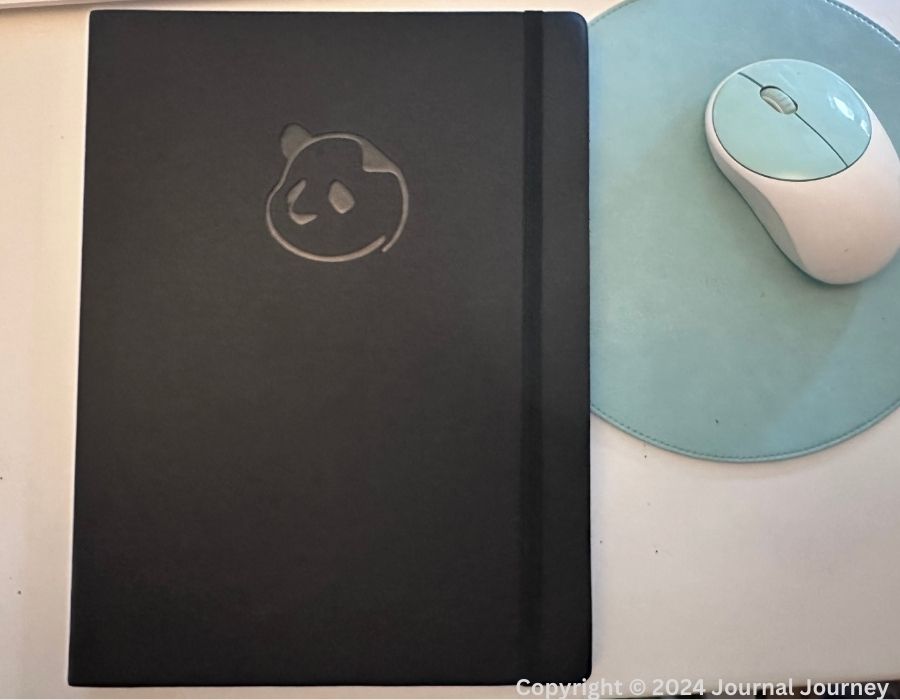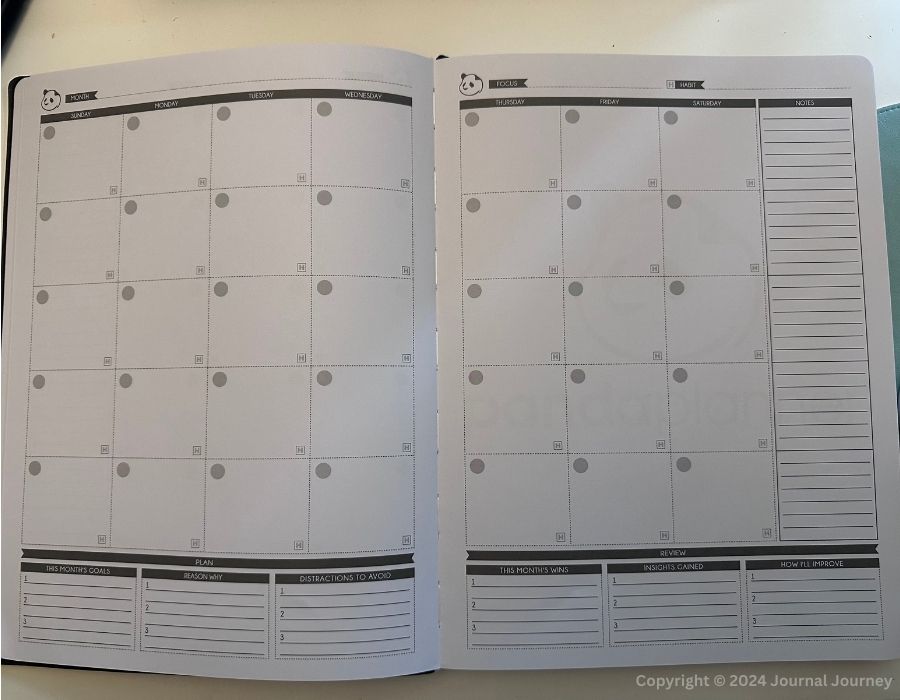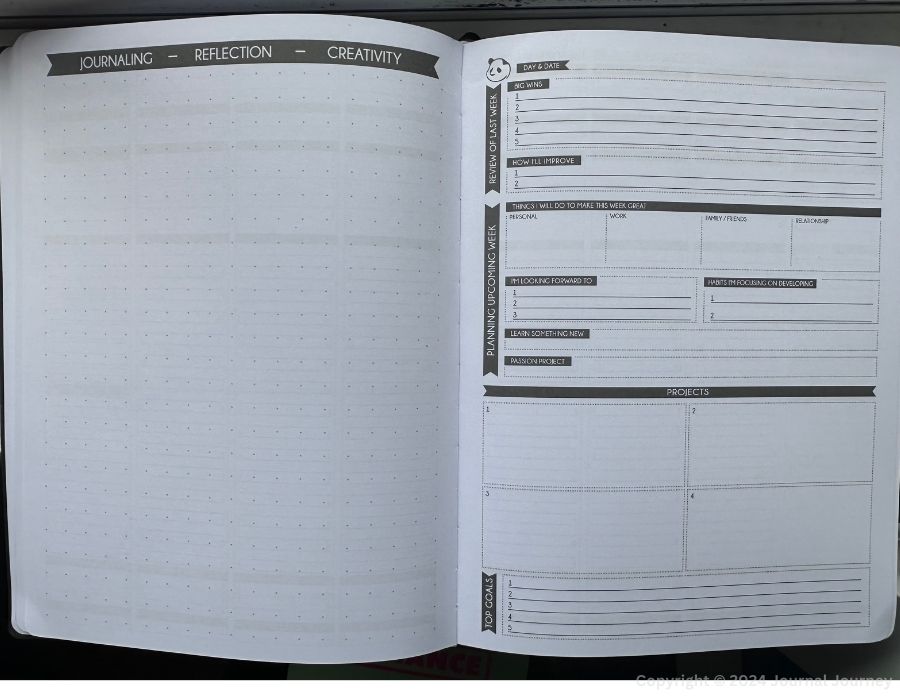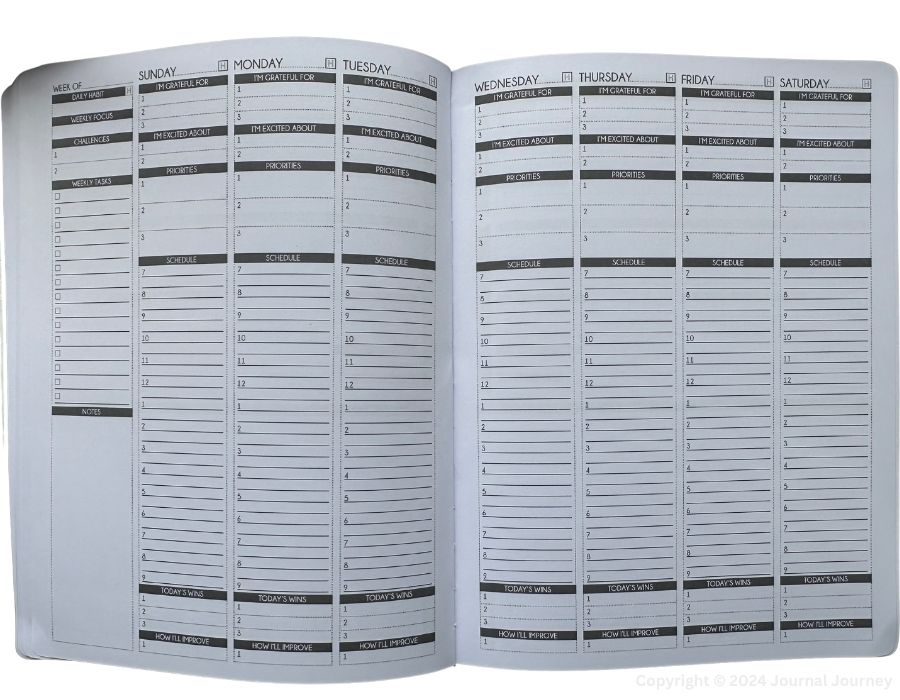Are you a weekly planner user or a daily planner user? Or both?
Keep attending the meetings back-to-back, juggling around multiple projects, and seeing the undone tasks piling up is such an exhausting feeling.
I hear that 1 of the reasons that people cannot achieve the tasks and goals is simply due to the lack of visibility. I have tried multiple types of journals/planners to improve my productivity through my 20+ years of experience working for multiple corporations in multiple roles including sales, software engineering, and project/product manager. In this article, I cover how the Panda Planner Weekly (Non-Dated Weekly Planner with Weekly & Monthly Review) helps you to have visibility over your weekly schedule and tasks as well as a balanced work and life with various aspects of life.

Disclaimer: All opinions are my own. As an Amazon Associate, I earn from qualifying purchases.
Why did I pick this Panda Planner weekly?
I originally was a bullet journal user; however, I have been struggling with repetitive actions I have needed to do Monthly/Weekly/Daily to adjust to my preference. Such as creating a monthly calendar, weekly calendar, hourly timetable, and so forth. I prefer to minimize the effort of those repetitive actions.
Additionally, I have been curious about a new type of planner that could give me new insights/methods, such that I can increase my productivity and move my life to the next level.
After I researched other types of journals/planners, I picked Panda Planner Weekly. Because there are enriched weekly reviews/plan pages as well as weekly spread pages that help to envision the upcoming week’s schedule.
1. What is a Panda Planner Weekly?
- Undated 12 months paper planner, produced by Mike Leip
- Non-printed month label
- Printed Weekday label
- The week starts on Sunday
- Softcover
- Letter size (I put the below picture for reference)

- 29 oz (821g)
- Pages consist of…
- 12 Monthly pages (first 24 pages of the planner)
- 52 Weekly pages (start after Monthly pages)
- 4 pages per 1 week x 52 weeks
- Page.1: free blank dotted page (JOURNALING – REFLECTION –
- CREATIVITY)
- Page.2: Weekly review & Weekly planning
- Page.3-4: Weekly Spread
- 4 pages per 1 week x 52 weeks
- 5 blank Note pages at the end
2. Feature Overview
2-1. Monthly Pages
(Monthly Calnder w/ Plan & Review)

The Monthly page is a 2-page spread for each month, and the standard calendar layout starts Sunday.
- MONTH (not labeled)
- FOCUS
- HABIT
- Undated, 1 Habit tracker each day
- PLAN
- 3 THIS MONTH’S GOAL
- 3 REASON WHY
- 3 DISTRACTIONS TO AVOID
- REVIEW
- 3 THIS MONTH’S WINS
- 3 INSIGHTS GAINED
- 3 HOW I’LL IMPROVE
- NOTES
2-1-1. What was effective for me
- 3 DISTRACTIONS TO AVOID
When distraction occurs, I briefly record the information of when/why/how long it occurred. As I had this information in my notes,I was aware of many kinds of distractions as part of my daily/weekly review. However, I never prioritized which distractions I needed to fix first. In this section, I can pick the top 3 distractions. Once I pick, I prepare its possible solutions proactively.
As I have the solution in advance, when the distraction occurs, I can pull myself back on track instead of getting distracted further.
- Standard Calendar with enough space on each day
My preference is a standard calendar, not a linear. I generally use the calendar for 2 information – important plans & health logs. Each day comes with enough space that I can write down, which makes it easy to view and analyze my health trends.
For instance, at some months, I record the sleep hours and my food craves, and see if those 2 factors are relative. Because there were days I failed to control food craves, and some other days I succeeded in controlling, I suspected that my total sleep hours were not enough, which caused less food control. For detailed health logs, I use Apple Health digitally, but searching some relativity of some health data, a paper planner is simpler for me.

– Expect the unexpected.
– Put only required data into the calendar. Sometimes it is easier to perform analysis than the Apple Health app.
2-1-2. What was NOT effective to me
- Habit of this Month, Each day with 1 Habit Tracker
My preference for a habit tracker is a linear day display such that I can easily track the total number of consecutive days I succeeded, how many days I was off the track, how many days I needed back on track etcetera. The total number of these days shows my habit generation trend, which will make it easy to plan a strategy.
- Missing Annual Goal page
As this planner covers 12 months, I prefer to have an annual goal at the beginning to be accessible in the same planner
- Starting Sunday
Printed weekdays are pretty handy, but adding a weekly label on the monthly calendar is fairly easy. I prefer my week to start Monday, and I believe some in the service industry take days off in the middle of the week and start their week such as Wednesday.

– Not Habit tracker friendly
– This planner is “Weekly” focused. No Annual/Quarterly plan/review.
2-2. Weekly Pages
As mentioned above, Weekly Pages is provided with 4 pages long. The first 2 pages are Weekly Planning and Review, and the next pages are Weekly Spread with Daily Sections.
2-2-1. Weekly Review & “Enriched” Plan

It includes:
- The Left Page is a free page with a dotted
- Day & Date
- REVIEW OF LAST WEEK
- 5 BIG WINS
- 2 HOW I’LL IMPROVE
- PLANNING UPCOMING WEEK
- THINGS I WILL DO TO MAKE THIS WEEK GREAT
- PERSONAL
- WORK
- FAMILY / FRIENDS
- RELATIONSHIP
- I’M LOOKING FORWARD TO
- HABITS I’M FOCUSING ON DEVELOPING
- LEARN SOMETHING NEW
- PASSION PROJECT
- THINGS I WILL DO TO MAKE THIS WEEK GREAT
- 4 PROJECTS
- 5 TOP GOALS
2-2-1-1. What was effective for me
- Entire blank page on the left page
When I review the previous week, I need to do a quick brain dump by looking at the previous week’s activity. For instance, when I did not finish the task as I planned, I needed to analyze it. I just keep writing down into the blank space whatever comes up in my mind – why uncompleted? Where am I stacked? How did I feel while I was on the task? Did I know I’m getting delayed? Etcetera… Based on that, I make a hypothetical strategy to finish the uncompleted task next week.
- 4 PROJECTS
4 Project section provides plenty of space so that you can break down into sub-tasks and next actions.
- LEARN SOMETHING NEW
This saved me from the procrastinated work. Some projects keep popping up in my mind every week, but is get pushed away due to other higher-priority tasks. I put the procrastinated work of step 1. (starting small). Then it leads to the next step and I can move forward even if it is a small step. Such as reading a book. Bringing up one task every week is a pretty effective reminder to make it actionable.
- PASSION PROJECT
As my work is very scientific, I intentionally proceed with some kind of Arty activity during the week such as playing the piano, creating fabrics, paintings, etc. It is refreshing to use different areas of the Brain! Since I started to write it down, I forget less about this Arty engagement 🙂

This Planning page provides you with new aspects of the Weekly Plan
2-2-1-2. What was NOT effective to me
- HABITS I’M FOCUSING ON DEVELOPING
this resulted in repetitive entry. The habits I’m trying to build on require a longer span of 3-6 months or more to get auto-pilot. Therefore, I did not need this section. I just used it as a weekly reminder of the habits I have been working on in the past months.
- Missing reward check box
I love to make check marks for completed tasks at the end of the week. That is such a small reward, but gives me huge psychological satisfaction. I manually added a checkbox for several areas.

As I track habits for the long term, weekly development was not really useful.
2-2-2. Weekly Spread w/ Daily Sections

It includes:
- WEEK OF xxx
- DAILY HABIT
- Weekly Focus
- 2 CHALLENGES
- 15 WEEKLY TASKS w/ checkbox
- NOTES
- 7 days vertical section starting Sunday
- Each Daily Section includes:
- Printed weekday label
- 1 habit tracker box
- 3 I’M GRATEFUL FOR
- 2 I’M EXCITED ABOUT
- 3 PRIORITIES
- SCHEDULE – timetable from 7 am to 9 pm)
- 3 TODAY’S WINS
- 1 HOW I’LL IMPROVE
2-2-2-1. What was effective for me
- 1 week overview which is constantly visible on my desk.
It gives me the following effect :
1. Awareness of the Date and Time is passing.
On Monday, I feel 1 out of 7 days has done. On Wednesday, more than 50% is done for the week, and so forth. This reminds me of the remaining times that give me pressure and the opportunity to strategy how to finish the remaining tasks
2. Better time visualization. Seeing hourly slots upfront esp. meetings for the entire week makes me flexible for the remaining date and time.
First, I look at the digital calendar and check all meeting invitations for next week. Second, I pick only “mandatory” ones and put them into my hour slot. Third, I made the appointment to proceed with my projects. If not enough time left, then I vet which meetings I can reject or ask to reschedule.
This information is available in Google Calendar or Outlook Calendar; However, this information is constantly visible on my desk, and there is no need to search or click to bring it up.
- Less flipping back and forth b/w the weekly planning page and the daily section
Just a single flip page takes me to the weekly planning page and free space, which makes it easy to remind myself what I planned at the beginning of the week.
This is a handy reminder. I don’t remember all the content of the weekly plan as the weekday goes by; therefore, just 1 page back and viewing all the content is the best accessibility I have experienced.

This Planning page provides you with new aspects of the Weekly Plan
2-2-2-2. What was NOT effective to me
- Daily “PRIORITY” is too small.
I believe this is the trade-off of using Daily Planner, but it is very small, and I needed to write w/ small fonts, or some keywords only.
- The printed timetable in the Daily “SCHEDULE” is from 7 am to 9 pm.
As I’m in the global business, my date starts at 4 am. So the table did not fit my hourly schedule.
- A week starting Sunday
I prefer to do a weekly review and weekly planning on Sunday so that I can plan upcoming Monday through the next Sunday. This may be just a psychological thing for me, but If I need to start a week on Sunday, I need to do weekly review and planning on Saturday. That I do not prefer. So in this weekly spread page, I used the leftmost Sunday section on the last day of the week.

As I track habits for the long term, weekly development was not useful.
5. Best for Who?
This planner is for people who
- Never used the planner in your life (Because daily input/output is very minimal on this planner)
- Are willing to learn the system how to make your life productive AND happier
- Weekly planner lover
6. NOT for Who?
This planner is NOT for people who
- Needs dedicated 1-2 pages per day
- Heavily journaling every day
- Prefer starting Monday as a week
- Commute with public transportation every day, or heavily travel (as this planner is letter size and high-quality paper and cover, so it is a bit heavy)
- Needs Annual/Quarterly plan & review
This is all my review for this Panda Planner weekly. Below is about the product I affiliate, so if you guys are not interested, pls ignore below. Thanks for reading till the end!
